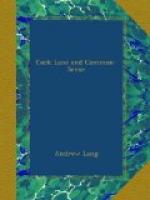This, though a striking, is an isolated and perhaps a casual example of recurrence and uniformity in evidence. Mr. Tylor’s Primitive Culture is itself a store-house of other examples, to which more may easily be added. For example, there is the old and savage belief in a ‘sending’. The medicine-man, or medium, or witch, can despatch a conscious, visible, and intelligent agent, non-normal, to do his bidding at a distance. This belief is often illustrated in the Scandinavian sagas. Rink testifies to it among the Eskimo, Grinnell among the Pawnees: Porphyry alleges that by some such ’telepathic impact’ Plotinus, from a distance, made a hostile magician named Alexander ‘double up like an empty bag,’ and saw and reported this agreeable circumstance. {352} Hardly any abnormal phenomenon or faculty sounds less plausible, and the ‘spectral evidence’ for the presence of a witch’s ‘sending,’ when the poor woman could establish an alibi for her visible self, appeared dubious even to Cotton Mather. But, in their Phantasms of the Living, Messrs. Gurney and Myers give cases in which a visible ‘sending’ was intentionally emitted by Baron Schrenck Notzing, by a stock-broker, by a young student of engineering, and by a French hospital nurse, to take no other instances. The person visited frequently by the ‘sendings’ in the last cases was a French physician engaged in the hospital, who reports and attests the facts. All the cases are given at first hand on the testimony of the senders and of the recipients of the sendings. Bulwer Lytton was familiar with the belief, and uses the ‘shining shadow’ in A Strange Story. Now here is uniform recurrent evidence from widely severed ages, from distant countries, from the Polar North, the American prairie, Neoplatonic Egypt and Greece, England and New England of the seventeenth century, and England and Germany of today. The ‘creeds and characters of the observers’ are as ‘different’ as Neoplatonism, Shamanism, Christianity of divers sects, and probably Agnosticism or indifference. All these conditions of unvarying testimony constitute good evidence for institutions and customs; anthropologists, who eagerly accept such testimony in their own studies, may decide as to whether they deserve total neglect when adduced in another field of anthropology.
Turning from ‘sendings,’ or ‘telepathy’ voluntarily brought to bear on one living person by another, we might examine ’death-bed wraiths,’ or the telepathic impact—’if that hypothesis of theirs be sound’—produced by a dying on a living human being. A savage example, in which a Fuegian native on board an English ship saw his father, who was expiring in Tierra del Fuego, has the respectable authority of Mr. Darwin’s Cruise of the Beagle. Instances, on the other hand, in which Australian blacks, or Fijians, see the phantasms of dead kinsmen warning them of their decease (which follows punctually) may be found in Messrs. Fison and Howitt’s Kamilaroi and Kurnai.




